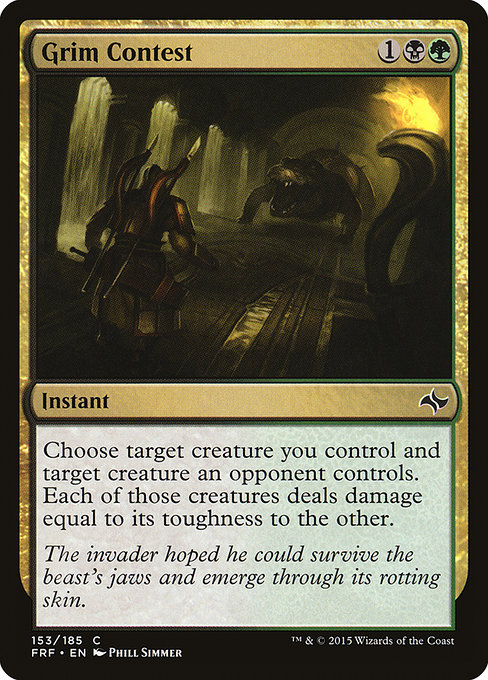
Image courtesy of Scryfall.com
Grim Contest: Naming a Moment of Clash in Fate Reforged
There’s something irresistibly cinematic about a card whose name reads like a headline from a tavern rumor: Grim Contest. When you pull it from Fate Reforged, you’re not just looking at a three-mana instant; you’re peering into a crafted little vignette where cooperation, risk, and raw combat all collide in a single moment on the battlefield 🧙♂️⚔️. The card’s two-color identity—black and green—binds the bite of black with the resilience of green, setting the stage for a contest that can swing the board in a heartbeat. The naming itself hints at a grim, almost ritualistic duel where two creatures are pressed into a deadly exchange, and the result can hinge on the toughness of the fighters involved.
What Grim Contest does, in plain terms
The card’s core effect is deceptively elegant: you choose a target creature you control and a target creature your opponent controls. Then both creatures deal damage equal to their own toughness to the other. It’s a built-in, instant-speed trade that can clear a blocker, pry open a path for an alpha swing, or simply force a stubborn standoff into daylight. The mechanic reflects a classic tactical principle in black-green: leverage your own resilience and the burden of your opponent’s aggression to craft a favorable exchange 🧪🔥. In practice, you’re not just fighting the opponent’s creature—you’re fighting the board state and the tempo you can squeeze out of a single moment.
“The invader hoped he could survive the beast's jaws and emerge through its rotting skin.”
The flavor text anchors the card in a brutal theater of conflict that feels very Tarkir-adjacent, even if the text is quietly universal. The invader isn’t just trading hits; he’s bargaining with the ruin of the moment itself—risking his own creature’s life to deny a bigger threat a turn or two more of reign on the battlefield. That tension between hopeful resilience and grim inevitability is what keeps Grim Contest from becoming a one-note tempo play and instead turning it into a genuine narrative moment on the table 🎨.
Lore, design, and flavor in concert
Grim Contest is a common instant from Fate Reforged, a set that sits in the shadow of the Tarkir block’s warlike storytelling. The art by Phill Simmer—rendered in a stark, high-contrast frame—evokes a moment of stillness before the next swing of the ax. The black frame and the green mana echo the set’s duality: a world where ritual combat and primal growth coexist. The card’s name, paired with the explicit “contest” of two creatures, invites players to think about diplomacy in the midst of chaos: you negotiate with the battlefield, not just the opponent. And yes, there’s a little wicked humor in the fact that a contest so grim can be resolved in a single, elegant instant 🧙♂️💎⚔️.
Strategic take: where Grim Contest shines in a BG shell
In deckbuilding terms, Grim Contest slots naturally into black-green midrange and tempo shells. Its mana cost of 1 generic, B, and G equals a compact, efficient play that can fit into early or mid-game lines. Here are practical angles to consider:
- Trade leverage: If you have a 2/2 on board and your opponent fronts a 2/2 or 3/3, Grim Contest can force a mutual removal that often leaves you with the board advantage if you’ve planned for it.
- Protective synergy: Pair the spell with creatures that benefit from surviving a combat, or with pump effects that pad your creature’s toughness—your own creature’s toughness becomes your shield as the damage is assigned.
- Tempo and late-game payoff: Casting it when you’re ahead on board can prune your opponent’s threats for good, while still leaving you with value if your own creature’s toughness is substantial.
- Risk vs. reward: The card does not discriminate—your creature faces the same hazard as your opponent’s. It’s a double-edged blade, so it shines when you’re prepared to absorb some swing in exchange for removing a bigger problem on the other side.
In the current modern environment, Grim Contest remains playable in formats where BG is a recognized color identity, especially in control-leaning or midrange decks that prize efficient answers with a twist of inevitability. The instant-speed nature means you can ambush an opposing combat phase or respond to a sudden aggression with calculated precision. And for EDH/Commander circles, it’s a flexible tool in slower, value-driven greens and black strategies, offering a cosmetic flash of drama in long games 🧭🎲.
Collectibility, art, and market snapshot
As a common rarity, Grim Contest sits at a budget-friendly tier, frequently sliding into playsets rather than chase-lists. The provided card data shows modest prices—foil variants command a premium, but even there you’re looking at accessible values compared to the bulk of collectible staples. The dual-color identity, the classic instant-speed interaction, and the evocative flavor text combine to give this card staying power in casual play and themed decks. The print run in Fate Reforged also contributes to a sense of nostalgia for players who caught the set during its initial release window, reminding us of the evolving interconnectedness between storytelling and card design 🧙♂️🎨.
Flavor, function, and lore converge here—the name suggests a moment of grim theater, the card delivers a practical engine for battlefield parity, and the art seals the moment in memory. For collectors who chase complete sets or nostalgic fragments from Fate Reforged, Grim Contest offers both a playable tool and a storytelling bead in a broader mosaic of Tarkir’s shattered world. The card’s presence in multiple formats continues to keep its identity vibrant in the modern landscape, a reminder that even a common can carry a memorable moment when the game is played with heart and a little edge 🔥💎.